
Illustrative Math Alignment: Grade 7 Unit 2
Introducing Proportional Relationships
Lesson 14: Four Representations
Use the following Media4Math resources with this Illustrative Math lesson.
| Thumbnail Image | Title | Body | Curriculum Nodes |
|---|---|---|---|
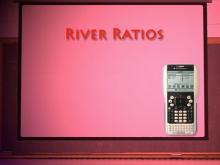
|
Closed Captioned Video: Algebra Applications: Variables and Equations, 3 | Closed Captioned Video: Algebra Applications: Variables and Equations, 3TopicEquations DescriptionThis segment explores the impact of colony collapse disorder on honey production using statistical data. It introduces box and whisker plots and the calculation of mean as statistical tools to analyze honey yields. Key vocabulary includes colony collapse disorder, box plot, and mean. Applications include modeling bee population declines and their broader ecological and agricultural implications. |
Applications of Equations and Inequalities, Variables and Unknowns, Variable Expressions and Applications of Ratios, Proportions, and Percents |

|
Closed Captioned Video: Algebra Applications: Variables and Equations, 3 | Closed Captioned Video: Algebra Applications: Variables and Equations, 3TopicEquations DescriptionThis segment explores the impact of colony collapse disorder on honey production using statistical data. It introduces box and whisker plots and the calculation of mean as statistical tools to analyze honey yields. Key vocabulary includes colony collapse disorder, box plot, and mean. Applications include modeling bee population declines and their broader ecological and agricultural implications. |
Applications of Equations and Inequalities, Variables and Unknowns, Variable Expressions and Applications of Ratios, Proportions, and Percents |

|
Closed Captioned Video: Algebra Applications: Variables and Equations, 3 | Closed Captioned Video: Algebra Applications: Variables and Equations, 3TopicEquations DescriptionThis segment explores the impact of colony collapse disorder on honey production using statistical data. It introduces box and whisker plots and the calculation of mean as statistical tools to analyze honey yields. Key vocabulary includes colony collapse disorder, box plot, and mean. Applications include modeling bee population declines and their broader ecological and agricultural implications. |
Applications of Equations and Inequalities, Variables and Unknowns, Variable Expressions and Applications of Ratios, Proportions, and Percents |

|
Closed Captioned Video: Algebra Applications: Variables and Equations, 3 | Closed Captioned Video: Algebra Applications: Variables and Equations, 3TopicEquations DescriptionThis segment explores the impact of colony collapse disorder on honey production using statistical data. It introduces box and whisker plots and the calculation of mean as statistical tools to analyze honey yields. Key vocabulary includes colony collapse disorder, box plot, and mean. Applications include modeling bee population declines and their broader ecological and agricultural implications. |
Applications of Equations and Inequalities, Variables and Unknowns, Variable Expressions and Applications of Ratios, Proportions, and Percents |

|
Closed Captioned Video: Algebra Applications: Variables and Equations, 3 | Closed Captioned Video: Algebra Applications: Variables and Equations, 3TopicEquations DescriptionThis segment explores the impact of colony collapse disorder on honey production using statistical data. It introduces box and whisker plots and the calculation of mean as statistical tools to analyze honey yields. Key vocabulary includes colony collapse disorder, box plot, and mean. Applications include modeling bee population declines and their broader ecological and agricultural implications. |
Applications of Equations and Inequalities, Variables and Unknowns, Variable Expressions and Applications of Ratios, Proportions, and Percents |

|
Closed Captioned Video: Algebra Applications: Variables and Equations, 3 | Closed Captioned Video: Algebra Applications: Variables and Equations, 3TopicEquations DescriptionThis segment explores the impact of colony collapse disorder on honey production using statistical data. It introduces box and whisker plots and the calculation of mean as statistical tools to analyze honey yields. Key vocabulary includes colony collapse disorder, box plot, and mean. Applications include modeling bee population declines and their broader ecological and agricultural implications. |
Applications of Equations and Inequalities, Variables and Unknowns, Variable Expressions and Applications of Ratios, Proportions, and Percents |

|
Closed Captioned Video: Algebra Applications: Variables and Equations, 3 | Closed Captioned Video: Algebra Applications: Variables and Equations, 3TopicEquations DescriptionThis segment explores the impact of colony collapse disorder on honey production using statistical data. It introduces box and whisker plots and the calculation of mean as statistical tools to analyze honey yields. Key vocabulary includes colony collapse disorder, box plot, and mean. Applications include modeling bee population declines and their broader ecological and agricultural implications. |
Applications of Equations and Inequalities, Variables and Unknowns, Variable Expressions and Applications of Ratios, Proportions, and Percents |

|
Closed Captioned Video: Algebra Applications: Variables and Equations, 3 | Closed Captioned Video: Algebra Applications: Variables and Equations, 3TopicEquations DescriptionThis segment explores the impact of colony collapse disorder on honey production using statistical data. It introduces box and whisker plots and the calculation of mean as statistical tools to analyze honey yields. Key vocabulary includes colony collapse disorder, box plot, and mean. Applications include modeling bee population declines and their broader ecological and agricultural implications. |
Applications of Equations and Inequalities, Variables and Unknowns, Variable Expressions and Applications of Ratios, Proportions, and Percents |

|
Closed Captioned Video: Algebra Applications: Variables and Equations, 3 | Closed Captioned Video: Algebra Applications: Variables and Equations, 3TopicEquations DescriptionThis segment explores the impact of colony collapse disorder on honey production using statistical data. It introduces box and whisker plots and the calculation of mean as statistical tools to analyze honey yields. Key vocabulary includes colony collapse disorder, box plot, and mean. Applications include modeling bee population declines and their broader ecological and agricultural implications. |
Applications of Equations and Inequalities, Variables and Unknowns, Variable Expressions and Applications of Ratios, Proportions, and Percents |
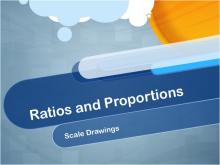
|
Closed Captioned Video: Ratios and Proportions: Scale Drawings | Closed Captioned Video: Ratios and Proportions: Scale DrawingsTopicRatios DescriptionThe video explains how proportions are used to create scale drawings, ensuring geometric figures remain proportional. Examples include finding dimensions in similar triangles, scaling architectural models, and solving geometric problems. The concept of proportional relationships is key to accurate scaling. |
Ratios and Rates |

|
Closed Captioned Video: Ratios and Proportions: Solving Proportions | Closed Captioned Video: Ratios and Proportions: Solving ProportionsTopicRatios DescriptionThis video focuses on solving proportions algebraically, converting them into equations to solve real-world problems. Examples include predator-prey ratios, scaling pizza dough recipes, and creating shades of paint. The video demonstrates methods for handling terms in denominators and simplifying ratios to whole numbers. |
Ratios and Rates |
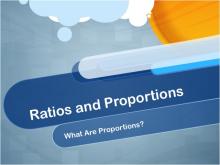
|
Closed Captioned Video: Ratios and Proportions: What Are Proportions? | Closed Captioned Video: Ratios and Proportions: What Are Proportions?TopicRatios DescriptionProportions are explained as equivalent ratios used to solve real-world problems. Examples include matching juice mixtures and adjusting recipes. The video uses ratio tables and number lines to scale ratios proportionally in practical applications. |
Ratios and Rates |
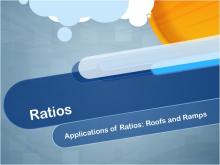
|
Closed Captioned Video: Ratios: Application of Ratios: Roofs and Ramps | Closed Captioned Video: Ratios: Application of Ratios: Roofs and RampsTopicRatios DescriptionThe video covers practical applications of ratios for measuring slopes of roofs and ramps. Examples include comparing roof pitches, calculating base lengths of roofs, and determining ramp heights. Ratios provide clarity for gradual slopes. |
Ratios and Rates and Applications of Ratios, Proportions, and Percents |

|
Closed Captioned Video: Ratios: Application of Ratios: Roofs and Ramps | Closed Captioned Video: Ratios: Application of Ratios: Roofs and RampsTopicRatios DescriptionThe video covers practical applications of ratios for measuring slopes of roofs and ramps. Examples include comparing roof pitches, calculating base lengths of roofs, and determining ramp heights. Ratios provide clarity for gradual slopes. |
Ratios and Rates and Applications of Ratios, Proportions, and Percents |

|
Closed Captioned Video: Ratios: Application of Ratios: Roofs and Ramps | Closed Captioned Video: Ratios: Application of Ratios: Roofs and RampsTopicRatios DescriptionThe video covers practical applications of ratios for measuring slopes of roofs and ramps. Examples include comparing roof pitches, calculating base lengths of roofs, and determining ramp heights. Ratios provide clarity for gradual slopes. |
Ratios and Rates and Applications of Ratios, Proportions, and Percents |

|
Closed Captioned Video: Ratios: Application of Ratios: Roofs and Ramps | Closed Captioned Video: Ratios: Application of Ratios: Roofs and RampsTopicRatios DescriptionThe video covers practical applications of ratios for measuring slopes of roofs and ramps. Examples include comparing roof pitches, calculating base lengths of roofs, and determining ramp heights. Ratios provide clarity for gradual slopes. |
Ratios and Rates and Applications of Ratios, Proportions, and Percents |

|
Closed Captioned Video: Ratios: Application of Ratios: Roofs and Ramps | Closed Captioned Video: Ratios: Application of Ratios: Roofs and RampsTopicRatios DescriptionThe video covers practical applications of ratios for measuring slopes of roofs and ramps. Examples include comparing roof pitches, calculating base lengths of roofs, and determining ramp heights. Ratios provide clarity for gradual slopes. |
Ratios and Rates and Applications of Ratios, Proportions, and Percents |

|
Closed Captioned Video: Ratios: Application of Ratios: Roofs and Ramps | Closed Captioned Video: Ratios: Application of Ratios: Roofs and RampsTopicRatios DescriptionThe video covers practical applications of ratios for measuring slopes of roofs and ramps. Examples include comparing roof pitches, calculating base lengths of roofs, and determining ramp heights. Ratios provide clarity for gradual slopes. |
Ratios and Rates and Applications of Ratios, Proportions, and Percents |

|
Closed Captioned Video: Ratios: Application of Ratios: Roofs and Ramps | Closed Captioned Video: Ratios: Application of Ratios: Roofs and RampsTopicRatios DescriptionThe video covers practical applications of ratios for measuring slopes of roofs and ramps. Examples include comparing roof pitches, calculating base lengths of roofs, and determining ramp heights. Ratios provide clarity for gradual slopes. |
Ratios and Rates and Applications of Ratios, Proportions, and Percents |

|
Closed Captioned Video: Ratios: Application of Ratios: Roofs and Ramps | Closed Captioned Video: Ratios: Application of Ratios: Roofs and RampsTopicRatios DescriptionThe video covers practical applications of ratios for measuring slopes of roofs and ramps. Examples include comparing roof pitches, calculating base lengths of roofs, and determining ramp heights. Ratios provide clarity for gradual slopes. |
Ratios and Rates and Applications of Ratios, Proportions, and Percents |
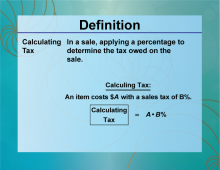
|
Definition--Ratios, Proportions, and Percents Concepts--Calculating Tax | Calculating TaxTopicRatios, Proportions, and Percents DefinitionCalculating tax involves determining the percentage amount to be added to the base price of a product or service. DescriptionCalculating tax is a fundamental application of percentages in real-world scenarios. When purchasing goods or services, the total cost is often the sum of the base price and the tax applied. Understanding how to calculate tax is essential for budgeting and financial literacy. For example, if a product costs $50 and the tax rate is 8%, the tax amount is calculated as 50 × 0.08 = 4 Therefore, the total cost is |
Applications of Ratios, Proportions, and Percents |

|
Definition--Ratios, Proportions, and Percents Concepts--Calculating Tax | Calculating TaxTopicRatios, Proportions, and Percents DefinitionCalculating tax involves determining the percentage amount to be added to the base price of a product or service. DescriptionCalculating tax is a fundamental application of percentages in real-world scenarios. When purchasing goods or services, the total cost is often the sum of the base price and the tax applied. Understanding how to calculate tax is essential for budgeting and financial literacy. For example, if a product costs $50 and the tax rate is 8%, the tax amount is calculated as 50 × 0.08 = 4 Therefore, the total cost is |
Applications of Ratios, Proportions, and Percents |

|
Definition--Ratios, Proportions, and Percents Concepts--Calculating Tax | Calculating TaxTopicRatios, Proportions, and Percents DefinitionCalculating tax involves determining the percentage amount to be added to the base price of a product or service. DescriptionCalculating tax is a fundamental application of percentages in real-world scenarios. When purchasing goods or services, the total cost is often the sum of the base price and the tax applied. Understanding how to calculate tax is essential for budgeting and financial literacy. For example, if a product costs $50 and the tax rate is 8%, the tax amount is calculated as 50 × 0.08 = 4 Therefore, the total cost is |
Applications of Ratios, Proportions, and Percents |

|
Definition--Ratios, Proportions, and Percents Concepts--Calculating Tax | Calculating TaxTopicRatios, Proportions, and Percents DefinitionCalculating tax involves determining the percentage amount to be added to the base price of a product or service. DescriptionCalculating tax is a fundamental application of percentages in real-world scenarios. When purchasing goods or services, the total cost is often the sum of the base price and the tax applied. Understanding how to calculate tax is essential for budgeting and financial literacy. For example, if a product costs $50 and the tax rate is 8%, the tax amount is calculated as 50 × 0.08 = 4 Therefore, the total cost is |
Applications of Ratios, Proportions, and Percents |

|
Definition--Ratios, Proportions, and Percents Concepts--Calculating Tax | Calculating TaxTopicRatios, Proportions, and Percents DefinitionCalculating tax involves determining the percentage amount to be added to the base price of a product or service. DescriptionCalculating tax is a fundamental application of percentages in real-world scenarios. When purchasing goods or services, the total cost is often the sum of the base price and the tax applied. Understanding how to calculate tax is essential for budgeting and financial literacy. For example, if a product costs $50 and the tax rate is 8%, the tax amount is calculated as 50 × 0.08 = 4 Therefore, the total cost is |
Applications of Ratios, Proportions, and Percents |

|
Definition--Ratios, Proportions, and Percents Concepts--Calculating Tax | Calculating TaxTopicRatios, Proportions, and Percents DefinitionCalculating tax involves determining the percentage amount to be added to the base price of a product or service. DescriptionCalculating tax is a fundamental application of percentages in real-world scenarios. When purchasing goods or services, the total cost is often the sum of the base price and the tax applied. Understanding how to calculate tax is essential for budgeting and financial literacy. For example, if a product costs $50 and the tax rate is 8%, the tax amount is calculated as 50 × 0.08 = 4 Therefore, the total cost is |
Applications of Ratios, Proportions, and Percents |
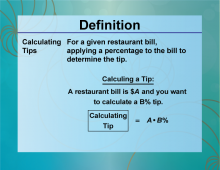
|
Definition--Ratios, Proportions, and Percents Concepts--Calculating Tips | Calculating TipsTopicRatios, Proportions, and Percents DefinitionCalculating tips involves determining the amount of money to give as a gratuity based on a percentage of the total bill. DescriptionCalculating tips is a common use of percentages in everyday life, particularly in service industries such as dining. Tips are usually calculated as a percentage of the total bill, and understanding how to compute this is important for both customers and service providers. For instance, if a meal costs $80 and you want to leave a 15% tip, the tip amount is calculated as 80 × 0.15 = 12 |
Applications of Ratios, Proportions, and Percents |

|
Definition--Ratios, Proportions, and Percents Concepts--Calculating Tips | Calculating TipsTopicRatios, Proportions, and Percents DefinitionCalculating tips involves determining the amount of money to give as a gratuity based on a percentage of the total bill. DescriptionCalculating tips is a common use of percentages in everyday life, particularly in service industries such as dining. Tips are usually calculated as a percentage of the total bill, and understanding how to compute this is important for both customers and service providers. For instance, if a meal costs $80 and you want to leave a 15% tip, the tip amount is calculated as 80 × 0.15 = 12 |
Applications of Ratios, Proportions, and Percents |

|
Definition--Ratios, Proportions, and Percents Concepts--Calculating Tips | Calculating TipsTopicRatios, Proportions, and Percents DefinitionCalculating tips involves determining the amount of money to give as a gratuity based on a percentage of the total bill. DescriptionCalculating tips is a common use of percentages in everyday life, particularly in service industries such as dining. Tips are usually calculated as a percentage of the total bill, and understanding how to compute this is important for both customers and service providers. For instance, if a meal costs $80 and you want to leave a 15% tip, the tip amount is calculated as 80 × 0.15 = 12 |
Applications of Ratios, Proportions, and Percents |

|
Definition--Ratios, Proportions, and Percents Concepts--Calculating Tips | Calculating TipsTopicRatios, Proportions, and Percents DefinitionCalculating tips involves determining the amount of money to give as a gratuity based on a percentage of the total bill. DescriptionCalculating tips is a common use of percentages in everyday life, particularly in service industries such as dining. Tips are usually calculated as a percentage of the total bill, and understanding how to compute this is important for both customers and service providers. For instance, if a meal costs $80 and you want to leave a 15% tip, the tip amount is calculated as 80 × 0.15 = 12 |
Applications of Ratios, Proportions, and Percents |

|
Definition--Ratios, Proportions, and Percents Concepts--Calculating Tips | Calculating TipsTopicRatios, Proportions, and Percents DefinitionCalculating tips involves determining the amount of money to give as a gratuity based on a percentage of the total bill. DescriptionCalculating tips is a common use of percentages in everyday life, particularly in service industries such as dining. Tips are usually calculated as a percentage of the total bill, and understanding how to compute this is important for both customers and service providers. For instance, if a meal costs $80 and you want to leave a 15% tip, the tip amount is calculated as 80 × 0.15 = 12 |
Applications of Ratios, Proportions, and Percents |

|
Definition--Ratios, Proportions, and Percents Concepts--Calculating Tips | Calculating TipsTopicRatios, Proportions, and Percents DefinitionCalculating tips involves determining the amount of money to give as a gratuity based on a percentage of the total bill. DescriptionCalculating tips is a common use of percentages in everyday life, particularly in service industries such as dining. Tips are usually calculated as a percentage of the total bill, and understanding how to compute this is important for both customers and service providers. For instance, if a meal costs $80 and you want to leave a 15% tip, the tip amount is calculated as 80 × 0.15 = 12 |
Applications of Ratios, Proportions, and Percents |
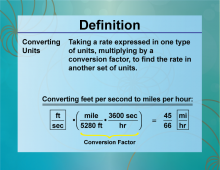
|
Definition--Ratios, Proportions, and Percents Concepts--Converting Units | Converting UnitsTopicRatios, Proportions, and Percents DefinitionConverting units involves changing a measurement from one unit to another using a conversion factor. DescriptionConverting units is essential in various fields such as science, engineering, and everyday life. It involves using ratios and proportions to switch between different measurement systems, such as converting inches to centimeters or gallons to liters. For example, to convert 5 miles to kilometers, knowing that 1 mile is approximately 1.60934 kilometers, you multiply 5 × 1.60934 = 8.0467 kilometers |
Ratios and Rates |
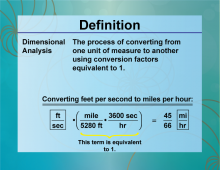
|
Definition--Ratios, Proportions, and Percents Concepts--Dimensional Analysis | Dimensional AnalysisTopicRatios, Proportions, and Percents DefinitionDimensional analysis is a method used to convert one unit of measurement to another using conversion factors. DescriptionDimensional analysis is a powerful tool in mathematics and science for converting units and solving problems involving measurements. It uses the principle of multiplying by conversion factors to ensure that units cancel out appropriately, leading to the desired unit. For example, to convert 50 meters per second to kilometers per hour, you use the conversion factors 1 meter = 0.001 kilometers and 1 hour = 3600 seconds: |
Applications of Ratios, Proportions, and Percents |

|
Definition--Ratios, Proportions, and Percents Concepts--Dimensional Analysis | Dimensional AnalysisTopicRatios, Proportions, and Percents DefinitionDimensional analysis is a method used to convert one unit of measurement to another using conversion factors. DescriptionDimensional analysis is a powerful tool in mathematics and science for converting units and solving problems involving measurements. It uses the principle of multiplying by conversion factors to ensure that units cancel out appropriately, leading to the desired unit. For example, to convert 50 meters per second to kilometers per hour, you use the conversion factors 1 meter = 0.001 kilometers and 1 hour = 3600 seconds: |
Applications of Ratios, Proportions, and Percents |

|
Definition--Ratios, Proportions, and Percents Concepts--Dimensional Analysis | Dimensional AnalysisTopicRatios, Proportions, and Percents DefinitionDimensional analysis is a method used to convert one unit of measurement to another using conversion factors. DescriptionDimensional analysis is a powerful tool in mathematics and science for converting units and solving problems involving measurements. It uses the principle of multiplying by conversion factors to ensure that units cancel out appropriately, leading to the desired unit. For example, to convert 50 meters per second to kilometers per hour, you use the conversion factors 1 meter = 0.001 kilometers and 1 hour = 3600 seconds: |
Applications of Ratios, Proportions, and Percents |

|
Definition--Ratios, Proportions, and Percents Concepts--Dimensional Analysis | Dimensional AnalysisTopicRatios, Proportions, and Percents DefinitionDimensional analysis is a method used to convert one unit of measurement to another using conversion factors. DescriptionDimensional analysis is a powerful tool in mathematics and science for converting units and solving problems involving measurements. It uses the principle of multiplying by conversion factors to ensure that units cancel out appropriately, leading to the desired unit. For example, to convert 50 meters per second to kilometers per hour, you use the conversion factors 1 meter = 0.001 kilometers and 1 hour = 3600 seconds: |
Applications of Ratios, Proportions, and Percents |

|
Definition--Ratios, Proportions, and Percents Concepts--Dimensional Analysis | Dimensional AnalysisTopicRatios, Proportions, and Percents DefinitionDimensional analysis is a method used to convert one unit of measurement to another using conversion factors. DescriptionDimensional analysis is a powerful tool in mathematics and science for converting units and solving problems involving measurements. It uses the principle of multiplying by conversion factors to ensure that units cancel out appropriately, leading to the desired unit. For example, to convert 50 meters per second to kilometers per hour, you use the conversion factors 1 meter = 0.001 kilometers and 1 hour = 3600 seconds: |
Applications of Ratios, Proportions, and Percents |

|
Definition--Ratios, Proportions, and Percents Concepts--Dimensional Analysis | Dimensional AnalysisTopicRatios, Proportions, and Percents DefinitionDimensional analysis is a method used to convert one unit of measurement to another using conversion factors. DescriptionDimensional analysis is a powerful tool in mathematics and science for converting units and solving problems involving measurements. It uses the principle of multiplying by conversion factors to ensure that units cancel out appropriately, leading to the desired unit. For example, to convert 50 meters per second to kilometers per hour, you use the conversion factors 1 meter = 0.001 kilometers and 1 hour = 3600 seconds: |
Applications of Ratios, Proportions, and Percents |
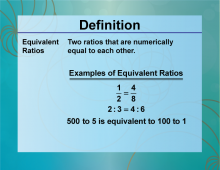
|
Definition--Ratios, Proportions, and Percents Concepts--Equivalent Ratios | Equivalent RatiosTopicRatios, Proportions, and Percents DefinitionEquivalent ratios are ratios that express the same relationship between quantities. DescriptionEquivalent ratios are fundamental in understanding proportions and scaling in mathematics. They represent the same relationship between quantities, even though the numbers themselves may differ. This concept is crucial in various applications, such as cooking, map reading, and creating models. For instance, the ratios 2:3 and 4:6 are equivalent because they both simplify to the same ratio when reduced. |
Ratios and Rates |
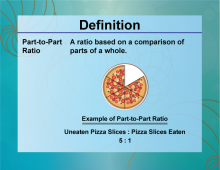
|
Definition--Ratios, Proportions, and Percents Concepts--Part-to-Part Ratios | Part-to-Part RatiosTopicRatios, Proportions, and Percents DefinitionPart-to-part ratios compare different parts of a whole to each other. DescriptionPart-to-part ratios are used to compare different parts of a whole, providing a way to understand the relationship between different components. This type of ratio is essential in fields such as statistics, biology, and economics. For example, if a class has 10 boys and 15 girls, the part-to-part ratio of boys to girls is 10:15, which simplifies to 2:3. |
Ratios and Rates |
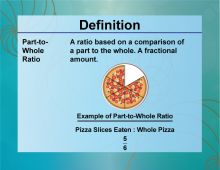
|
Definition--Ratios, Proportions, and Percents Concepts--Part-to-Whole Ratios | Part-to-Whole RatiosTopicRatios, Proportions, and Percents DefinitionPart-to-whole ratios compare one part of a whole to the entire whole. These ratios are more commonly known as fractions. DescriptionPart-to-whole ratios are used to compare a part of a whole to the entire whole, providing insights into the composition of a dataset or population. This type of ratio, more commonly referred to as fractions, is widely used in statistics, finance, and everyday decision-making. |
Ratios and Rates |
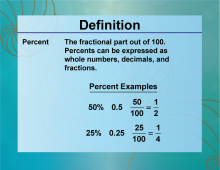
|
Definition--Ratios, Proportions, and Percents Concepts--Percent | PercentTopicRatios, Proportions, and Percents DefinitionA percent is a ratio that compares a number to 100. DescriptionPercentages are a fundamental concept in mathematics, representing a ratio out of 100. They are used in various applications, including finance, statistics, and everyday calculations such as discounts and interest rates. For example, if you score 45 out of 50 on a test, your percentage score is (45/50) × 100 = 90% |
Percents |
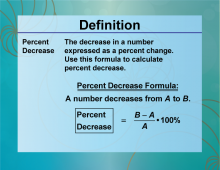
|
Definition--Ratios, Proportions, and Percents Concepts--Percent Decrease | Percent DecreaseTopicRatios, Proportions, and Percents DefinitionPercent decrease measures the reduction in value expressed as a percentage of the original value. DescriptionPercent decrease is used to quantify the reduction in value over time, expressed as a percentage of the original value. It is commonly used in finance, economics, and everyday scenarios such as price reductions and weight loss. For example, if the price of a jacket drops from $80 to $60, the percent decrease is calculated as (80 − 60)/80 × 100 = 25%. |
Percents |
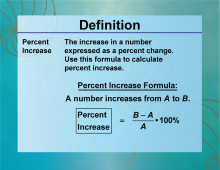
|
Definition--Ratios, Proportions, and Percents Concepts--Percent Increase | Percent IncreaseTopicRatios, Proportions, and Percents DefinitionPercent increase measures the growth in value expressed as a percentage of the original value. DescriptionPercent increase is used to quantify the growth in value over time, expressed as a percentage of the original value. It is commonly used in finance, economics, and everyday scenarios such as salary increases and population growth. For example, if the price of a stock rises from \$50 to \$75, the percent increase is calculated as (75 − 50)/50 × 100 = 50% |
Percents |

|
Definition--Ratios, Proportions, and Percents Concepts--Percent of a Number | Percent of a NumberTopicRatios, Proportions, and Percents DefinitionPercent of a number involves calculating the amount represented by a certain percentage of that number. DescriptionUnderstanding percentages is crucial for working with finances, statistics, and data analysis. For instance, to find 20% of 50, multiply 50 by 0.20, resulting in 10. Likewise, it's important for everyday scenarios, such as calculating discounts during shopping. |
Percents |
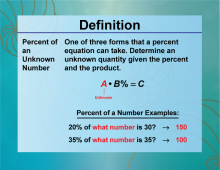
|
Definition--Ratios, Proportions, and Percents Concepts--Percent of an Unknown | Percent of an UnknownTopicRatios, Proportions, and Percents DefinitionPercent of an unknown refers to solving for an unknown quantity when given a percentage of that quantity. DescriptionKnowing how to find a percentage of an unknown variable is essential for solving equations in algebra. This concept appears in various situations, such as when determining discounts or portions of a total amount. For instance, if 20% of an unknown number equals 15, you can set up the equation: 0.20x = 15 |
Percents |
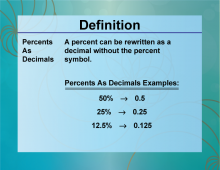
|
Definition--Ratios, Proportions, and Percents Concepts--Percents as Decimals | Percents as DecimalsTopicRatios, Proportions, and Percents DefinitionPercents as decimals involve converting a percentage into its decimal representation. DescriptionConverting percents to decimals is a key skill in mathematics, allowing students to perform calculations involving percentages more easily. To convert, divide the percent by 100. For example, 75% as a decimal is 0.75, calculated by dividing 75 by 100. This conversion is useful in many contexts, such as finance, where calculations are conducted using decimal values. Mastering this concept enables students to approach real-world problems with greater confidence and accuracy. |
Percents |
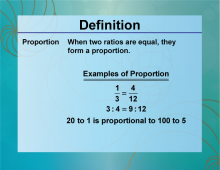
|
Definition--Ratios, Proportions, and Percents Concepts--Proportion | ProportionTopicRatios, Proportions, and Percents DefinitionA proportion is an equation that states that two ratios are equal. DescriptionUnderstanding proportions is essential in mathematics, as it is used to solve problems involving ratios and fractions. Proportions are commonly seen in real-world applications such as cooking, map measurements, and scale models. To illustrate, if there are 2 apples for every 3 oranges, the proportion can be expressed as 2:3. Solving proportions involves finding and solving an equivalent ratio. |
Proportions |
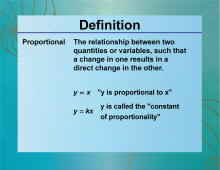
|
Definition--Ratios, Proportions, and Percents Concepts--Proportional | ProportionalTopicRatios, Proportions, and Percents DefinitionProportional refers to the relationship between two quantities where their ratio is constant. DescriptionProportional relationships are fundamental in mathematics and science, describing how one quantity changes in relation to another. This concept is used in various fields, including physics, economics, and engineering. For example, if the speed of a car is proportional to the time it travels, doubling the time will double the distance covered. Understanding proportionality helps students solve complex problems and apply mathematical reasoning in real-world situations. |
Proportions |